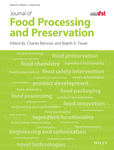Saccharomyces cerevisiae YE-7 reduces the risk of apple blue mold disease by inhibiting the fungal incidence and patulin biosynthesis
Funding information: Agriculture and Agri-Food Canada; Project of “Twelve-Five” Science and Technology Support Program in China, Grant/Award Numbers: 2015BAD16B02, 2015BAD16B08, 2015BAD19B02; Key Scientific Research Fund Project of Xihua University, Grant/Award Numbers: Z1620516, Z1620515, szjj2016-025; China Scholarship Council (CSC)—the China—Canada Joint PhD Program (to W. Li)
Abstract
The yeast strain, Saccharomyces cerevisiae YE-7, was tested to control the apple blue mold disease caused by Penicillium expansum and the accumulation of patulin mycotoxin. Compared with control, pre-treatment of pathogen-infected apples with YE-7 significantly reduced the incidence of blue mold diseases and patulin accumulation in rotten apple tissue by 48% and 42.6%, respectively. Interestingly, late treatment of pathogen-infected apples with YE-7 did not decrease patulin accumulation in the rotten tissue compared with pre-treatment or simultaneous-treatment. Independently, patulin amount and gene expression of isoepoxydon dehydrogenase were also measured. YE-7 pre-treated apples showed 75% and four times reduction in patulin accumulation and IDH gene expression, respectively. The results indicated that YE-7 directly affected patulin biosynthesis and did not affect accumulated patulin. On the other hand, cold storage enhanced the effect of YE-7 on apple blue mold disease incidence.
Practical applications
Postharvest blue mold decay caused by Penicillium expansum was important postharvest disease of apples. In addition, under favorable conditions, P. expansum can cause severe losses in apple fruits due to the production of patulin. In this study, a strain of S. cerevisiae (YE-7) was assessed for its efficacy not only in controlling apple blue mold diseases, but also in reducing patulin accumulation in fruit tissue. The research will give a practical way to control the decay in a bio-control way instead of the chemical.




